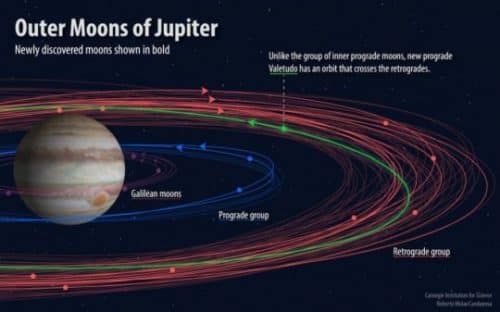The discovery puts the number of moons of the largest planet in the solar system at 79, more than any other planet in the solar system

Researchers have recently discovered 12 previously unknown moons orbiting the planet Jupiter, 11 of which are regular and one called "strange" by astronomers due to its tilted orbit and crossing the orbits of small moons moving in front of it. The discovery puts the number of moons of the largest planet in the solar system at 79, more than any other planet in the solar system.
A team led by Scott Shepherd of the Carnegie Institution was the first to spot the moons in the spring of 2017 during a search for distant objects in the solar system, as part of the search for a large planet suspected to be far beyond Pluto's orbit. It was the same team that discovered in 2014 the similarity between the orbits of some of the distant objects in the solar system that could be explained by the existence of a large planet. That theoretical planet is now referred to as Planet X or Planet Nine.
"Jupiter happened to be in the sky near the search field so we could combine the search for new moons around Jupiter at the same time as the search for planets at the edge of the solar system," said Shepherd.
Gareth Williams of the International Astronomical Union's Center for Small Objects in the Solar System used the team's observations to calculate the orbits of the newly discovered moons. "It took a year of observations to confirm that these objects are orbiting Jupiter," Williams said.
Nine of the new moons are part of a distant outer swarm of moons orbiting Jupiter in the opposite direction to Jupiter's rotation on its axis. This group has been divided into three subgroups - each probably a remnant of another large original moon that broke up during collisions with asteroids, comets or other moons. New moons of this type take about two years to orbit Jupiter.
Two other moons are part of an inner group of moons that orbit Jupiter with its direction of rotation. All the moons of this type move in the same direction and at the same inclination angles around Jupiter and therefore they are also considered fragments of a large moon that broke up. These two moons have a period of about a year around Jupiter.
The last discovery was of a strange object, with an orbit unlike that of any other moon of Jupiter. It is also probably the smallest moon of Jupiter, with a diameter of less than one kilometer.” Shepherd explained.
This moon also moves with the axis of Jupiter's rotation, it is more distant and has a higher inclination than the moons that move with the direction of Jupiter's rotation, and its orbital period around Jupiter is about a year and a half, however, its orbit is very elongated and it crosses that of the outer moons that move in the direction Opposite to the direction of Jupiter's rotation on its axis. "As a result, collisions between the strange moon and the oppositely moving moons may occur. "This is not a stable situation," says Shepherd. "Head-on collisions would have caused a rapid disintegration of these objects into dust." added
"It is possible that the variety of group routes we see today was created in the distant past using just such a mechanism. The team members believe that the small odd moon that moves with the axis of rotation of Jupiter, is a last remnant of a large moon that orbited Jupiter with the axis of rotation, which caused the formation of the opposite moving moons during a head-on collision.
The researchers suggested calling this moon Valetudo after the Roman goddess of health and hygiene and granddaughter of Jupiter, the king of the gods (and the foreign name of the planet Jupiter).
The researchers estimate that these collisions occurred shortly after the formation of the solar system, when the sun was still surrounded by a rotating disk of gas and dust from which the planets were formed, when the dust and gas dissipated, and not all these small moons were swirling and falling into Jupiter.
For a message from the Carnegie Institute

3 תגובות
It took them a year of observations to calculate the orbits, so that they even had something to calculate.
It took them a year to process the data? Incredible…
Interesting, just why in Nature
https://www.nature.com/articles/d41586-018-05725-6
"Found" only 10 moons
For the 12th nation of the Carnegie Institute
? ? ?